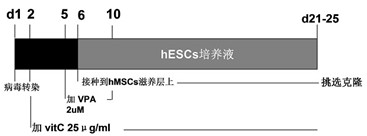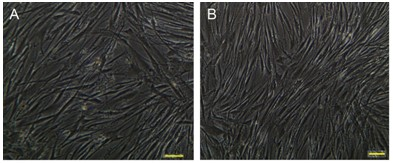Method for culturing induced pluripotent stem cells by using human mesenchymal stem cells as trophoblast
A technology of pluripotent stem cells and trophoblast cells, applied in the biological field, can solve the problems of high price, no proof, short culture time, etc., and achieve the effect of reducing pollution
- Summary
- Abstract
- Description
- Claims
- Application Information
AI Technical Summary
Problems solved by technology
Method used
Image
Examples
Embodiment 1
[0019] Example 1: Isolation and culture of human bone marrow mesenchymal stem cells, cryopreservation and recovery
[0020] (1) Isolation and culture of human bone marrow mesenchymal stem cells
[0021] Bone marrow from 3 healthy donors was collected under sterile conditions, anticoagulated with heparin, mononuclear cells were collected by density gradient centrifugation with Ficoll-paque (specific gravity 1.077), and the cells were collected in 5×10 5 cells / cm 2 Density inoculation, the culture medium is low-sugar DMEM (LG-DMEM) medium containing 10% (V / V) fetal bovine serum and 1% glutamine, placed at 37 0 C, 5% CO2 incubator culture. After 24 hours, the culture medium was replaced, the non-adherent cells were discarded, and there were spindle-shaped adherent cells. After that, the medium was changed every 3 days, and the adhesion and fusion of the primary cells reached 90%-95% in about 14 days. figure 2 A). They were digested with 0.25% trypsin-1 mmol EDTA, subculture...
Embodiment 2
[0024]Example 2: Preparation of human bone marrow mesenchymal stem cells as trophoblast cells
[0025] Human bone marrow mesenchymal stem cells of the 3rd to 5th generation were used as the trophoblast cells. The 6-well plate was pre-filled with 0.1% gelatin at 37 0 C for 1 h to overnight. Human bone marrow mesenchymal stem cells in 2×10 4 / cm 2 The density was seeded on gelatin-treated six-well plates, so that the cell confluency reached 80%-90% the next day. Treat with 10ug / ml mitomycin C for 2 hours to inactivate, the cell morphology after inactivation is basically the same as that before inactivation (see figure 2 ). The inactivated cells were used within 24 hours.
Embodiment 3
[0026] Example 3: Induction of human iPSCs using human bone marrow mesenchymal stem cells as trophoblast
[0027] Foreskin fibroblasts from children of the third generation (2-3 years old) were transfected twice with retrovirus carrying Klf4, Sox2, Oct4 and c-Myc transcription factors. After transfection, vitamin C 25ug / ml was added to the culture system until the clones were selected, VPA2 μM was added on the fifth day (5 days in total), and the transfected fibroblasts were inoculated into human bone marrow mesenchyme on the sixth day On the stem cell trophoblast cells, on the seventh day, replace with human ESCs culture medium containing 8ng / ml bFGF, 1% glutamine, 1% non-essential amino acids, 100μM and 20% serum replacement. Then change the medium every day until ESCs-like clones appear (see image 3 A), the border is clear and the cells are dense. Select one by one under the microscope, amplify and cultivate. Technical route see figure 1
PUM
 Login to View More
Login to View More Abstract
Description
Claims
Application Information
 Login to View More
Login to View More - R&D
- Intellectual Property
- Life Sciences
- Materials
- Tech Scout
- Unparalleled Data Quality
- Higher Quality Content
- 60% Fewer Hallucinations
Browse by: Latest US Patents, China's latest patents, Technical Efficacy Thesaurus, Application Domain, Technology Topic, Popular Technical Reports.
© 2025 PatSnap. All rights reserved.Legal|Privacy policy|Modern Slavery Act Transparency Statement|Sitemap|About US| Contact US: help@patsnap.com



